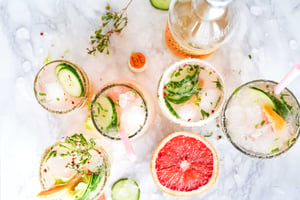2020 was a very turbulent and unpredictable year for everyone. Thankfully, 2021 brought more stability. With COVID-19 vaccines having been rolled out to the population, meeting our relatives and loved ones once again in person is within arm's reach. We believe that itself deserves a celebration and a toast, and the general consumer must agree, considering some experts estimate the global beverage market will be worth $1.5 trillion by the end of 2022. This article will look at the top beverage trends we see in H1 2022, according to Helio.
Sounds interesting? Schedule a quick demo with us!
To get started, let’s take a look at how beverage categories have been trending over the last few years:
When looking at sales velocity across categories, Coffee and Carbonated beverages have had top sales velocity over the years, with Carbonated Beverages having more volatility than Coffee.
Beyond the top categories, we can see that Kombucha sales velocity was in steady decline after 2018 and leveled out in 2021, while New Age Beverages & Juiceries rose in 2021. Additionally, Sport & Energy holds strong above these other categories. Non-Alc Beverages Other accelerated in the spring of 2020, but has since leveled out.
Top Ingredients of 2022
According to Helio, brands that offer drinks with attributes of Cacao, Chia, and Elderberry have the highest median Helio Growth Predictor score compared to brands that include other flavor attributes. These brands are the most likely to see considerable growth over the next twelve months.
Furthermore, both Apple and Honey share the highest density of brand counts with a median HGP exceeding 0.50, while “Cucumber” and “Monk [Fruit]”-related brands demonstrate strong offline sales growth over 20%.
Brands tracked in Helio that produce beverages with Chocolate and Caramel attributes showcase the largest social media followings.
Functional and Healthy Living Beverages
One central theme of beverages in 2021 is healthy living. Companies started to invest and launch food and drinks that feature immunity-boosting ingredients and other health benefits. The alternative drinks and plant-based beverages market also continued to grow in 2021, taking on new ingredients such as mushrooms and even algae.
Healthy living and wellness was the biggest trend in the beverage market in 2021, and still is to this day. A huge surge of consumers turned to healthier options for food and beverages in the wake of the COVID-19 pandemic. There is a more explicit focus on producing products that support both physical and mental health than ever before.
Numerous companies also started to use specialized ingredients and additions such as CBD, probiotics, and also adaptogens. These ingredients provide various benefits to help consumers relax after a hard day’s work to boosting energy levels to tackle the day ahead. In fact, “MCT Oil”, “Superfoods”, and “Active_Lifestyle” are attributes associated with No and Low Alcohol brands predicted to grow the fastest in the next 12 months. In addition, CBD and Hemp are associated with brands with high social following, and Alcohol Free & Cognitive attributes receiving the highest average online customer ratings.
Top Trending Attributes Among No/Low Alcohol Brands in Helio
Convenient Beverages
Convenience is also another huge trend across the beverages market. Wines and beers are not the only beverages that come pre-packaged and ready for consumption anytime anymore. In fact, Helio has data on more than 2,800 emerging brands that carry canned or bottled beverages, from lattes to kombuchas to non-alcoholic spirits and hydration-boosting thirst quenchers. More and more consumers are choosing beverages that can provide for their needs while on the go, delivering both energy and nutrition. This is why we also see plenty of beverages specifically designed to satisfy and satiate.
The metoric rise of lower calorie hard seltzer, led by White Claw, with sales growth doubling over the summer in 2019, is a well-known story. According to Allied Market Research, the total hard seltzer market is projected to reach $10.9 billion by 2027. While the popularity of pre-mixed canned or bottled cocktails was already on the rise, COVID-19 greatly accelerated the process. Off-premise dollar sales increased 156% percent for spirits-based hard seltzers for the 52-week period ending October 2, 2021. And it wasn’t just hard seltzers. Perhaps as a reaction from consumers looking for stronger flavors and higher alcohol content, the market for pre-mixed cocktails also took off, with sales for RTD cocktails growing 126% over the same period. And consumers also started purchasing this RTD alcohol in new ways during the pandemic, broadly adopting alcohol delivery service platforms. The biggest winner in this sector was Drizzly, which experienced 350% year-over-year sales growth in 2020.
Boxed Wine & Sustainability
Sustainability is another trending topic. In fact, it may be transforming from a trend to table stakes for brands that wish to remain competitive. According to research from Mintel, a global market research company, 53% of the Consumers in the US and 65% in the UK prefer products that are made with environmentally friendly practices.
The beverage industry uses energy-intensive processes to extract the raw products needed for the drinks. However, increased consumer awareness is pushing companies to adopt more sustainable methods. Boxed wine has also jumped into the beverage scene. It is another adaptation that emerged from the pandemic. Some argue that boxed wine leads to better sustainability practices compared to bottled wine. It can also preserve open wine better than bottled and is more hygienic due to its structure.
When it comes to Key Purchase Criteria that is most important to consumers when determing which wines to purchase, Value for Money, Packaging, and Flavor all rank highest. Among these criteria, Flavor tends to be correlated with the highest average customer review score, while Value for Money is correlated with a slightly lower average customer review score.
At-Home Cocktail Creations
DIY cocktail creations at home also boomed as we were stuck indoors for long periods of time. We adapted in different ways to keep ourselves entertained and busy while staying at home. As everything outside was closed, consumers began stocking their kitchen pantries and at-home bars with DIY cocktail ingredients. Unfortunately, you can only do so much at home if you’re not a professional mixologist.
To help enhance the at-home cocktail experience, DIY cocktail kits took the market by storm as people continued to experiment with flavors in their homes. Top DIY cocktail brands like Shaker & Spoon, Curious Elixirs, Cheeky Cocktails, and The Cocktail Box Co. have become household favorites, as their subscription boxes and pre-made mixers became a cause for celebration throughout 2021.
Sounds interesting? Schedule a quick demo with us!
Rise of Rum
Premium beverages, such as rum, are on the rise. According to the Wine & Spirits Trade, spiced and flavored rum increased 80% from 6 million bottles in 2014 to over 10 million in 2019. Knowing that consumers are willing to pay for quality, large alcohol manufacturers and corporations are marketing more premium rum brands as consumers continue to adopt a “less is more” approach to alcoholic beverages. They are drinking fewer but far more premium beverages.
Looking at an analysis for Key Purchase Criteria for spirits overall, Flavor, Packaging, and Value for Money are most important to consumers. Flavor is associated with the highest average customer review rating. Less important purchase criteria include Consistency, Giftable, Craftmanship, and Warmth. Warmth and Giftable are associated with the highest average customer reviews, respectively.
That concludes our top beverage trends in 2021. We can’t wait to see what 2022 holds!
Want to know more about the top new beverage brands and trends to stay ahead?
Request a Helio demo today!


